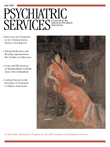Letter
In an article in the March issue, Vega and his group ( 1 ) described treatment barriers facing Hispanic patients across the country. They also offered several suggestions to increase access to mental health care for Hispanics, including telepsychiatry. Little has been written about telepsychiatry with Hispanic patients.
Telepsychiatry is an innovative and cost-effective way to increase access to mental health care ( 2 ). This increased access is the most compelling reason to utilize telepsychiatry. It is not a substitute for the patient-practitioner relationship but rather an enrichment in services.
The use of telepsychiatry to treat underserved minority groups and rural residents has been suggested, but there are obstacles to effective implementation ( 3 , 4 ). One obstacle is the lack of comfort with the technology, especially among elderly persons ( 4 ). Another is limitation of cultural acceptance of this treatment modality, especially in cultures that emphasize personal relationships. Third, the effects on the patient-practitioner relationship are relatively unexplored. There is some anecdotal reporting in the media of resistance to the use of telepsychiatry to serve one Hispanic subgroup, incarcerated Hispanics with mental health needs in San Juan, Puerto Rico ( 5 ). In this situation Hispanic individuals who were not employees of the prison would provide telepsychiatry services to Hispanic inmates. Prison employees rather than the inmates resisted this move and suggested that it was "second-class service." This may indicate a cultural resistance to the technology itself or perhaps something else altogether.
Hispanic culture relies heavily on nonverbal interactions, such as frowning, tipping the head, and so forth. These communication nuances provide an additional "channel" to receive and process information and give more depth to verbal communication. These nonverbal communications may be contradictory to the words used and are usually a more accurate reflection of internal processes. Ability to view these effectively can be influenced by the technology. High-resolution equipment, such as video conferencing, can provide a more accurate real-time image than the less expensive small-screen videophones, which are limited to telephone line transmission speed. Variations in technical equipment variations can influence the perception of other signs and symptoms in psychiatry as well, such as affect, psychomotor movements, and signs of movement disorders.
In our community-based outpatient clinic we recently deployed videophones to enhance medical psychiatric access to persons with serious mental illness. One Hispanic patient whose treatment included videophones reported marked satisfaction. There was already a clinical relationship between the provider and patient. Both had Spanish as a first language, and the sessions were conducted in that language. The previous solid clinical relationship allowed the videophone technology, despite its limitations, to be used when the patient's comorbid health problems prevented his travel to the facility. Videophones have been used with similar success with non-Hispanic veterans in comparable situations in our clinic.
Further investigation of the use of telepsychiatry and how culture influences its effectiveness are needed. As mental health professionals, we need to utilize all appropriate resources to improve access to care to the growing Hispanic populations. Improvements will have implications for others in the multicultural clinical environment.
1. Vega WA, Karno M, Alegria M, et al: Research issues for improving treatment of US Hispanics with persistent mental disorders. Psychiatric Services 58:385–394, 2007Google Scholar
2. Hyler SE, Gangure DP: A review of the costs of telepsychiatry. Psychiatric Services 54:976–980, 2003Google Scholar
3. Moran M: Telepsychiatry brings care to underserved populations. Psychiatric News 39(12):4, 2004Google Scholar
4. Rholand BM, Saleh SS, Roher JE, et al: Acceptability of telepsychiatry to a rural population. Psychiatric Services 51:672–674, 2000Google Scholar
5. No controls over telepsychiatry services [in Spanish]. El Vocero de Puerto Rico, Dec 18, 2006. Available at www.vocero.com. Accessed Dec 18, 2006Google Scholar



